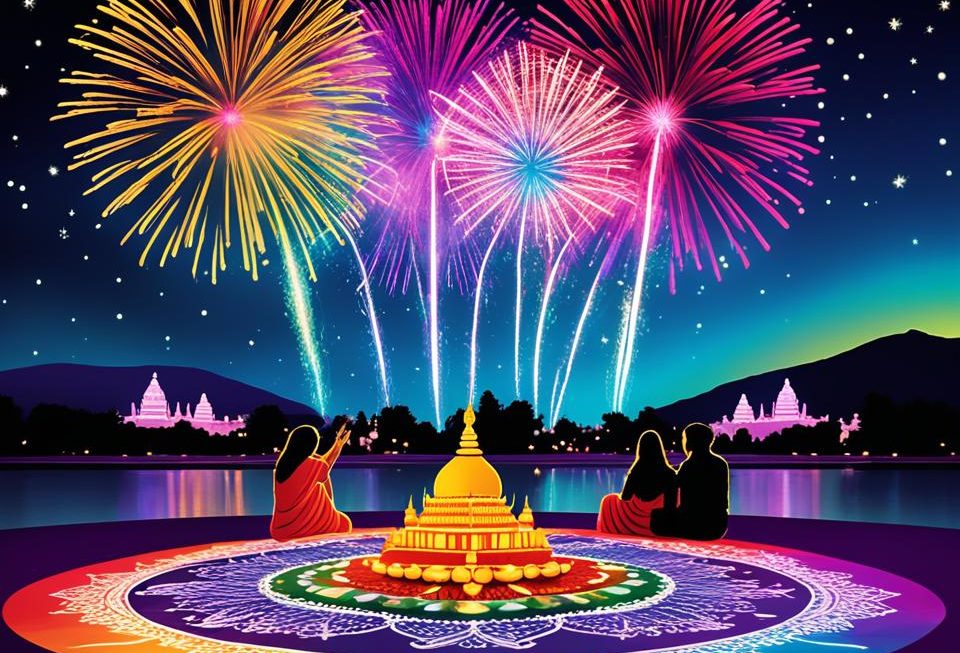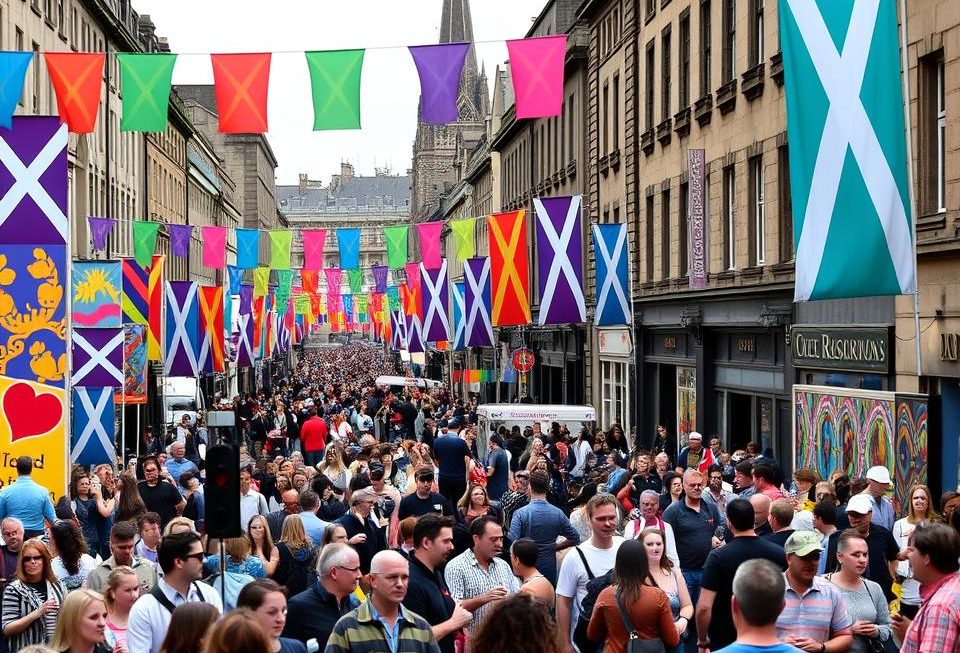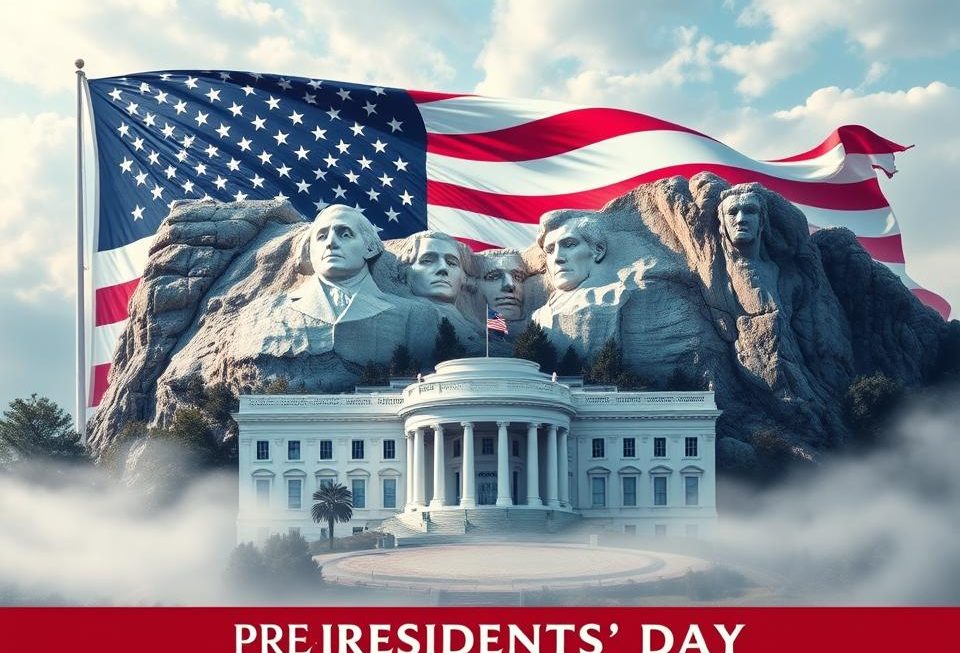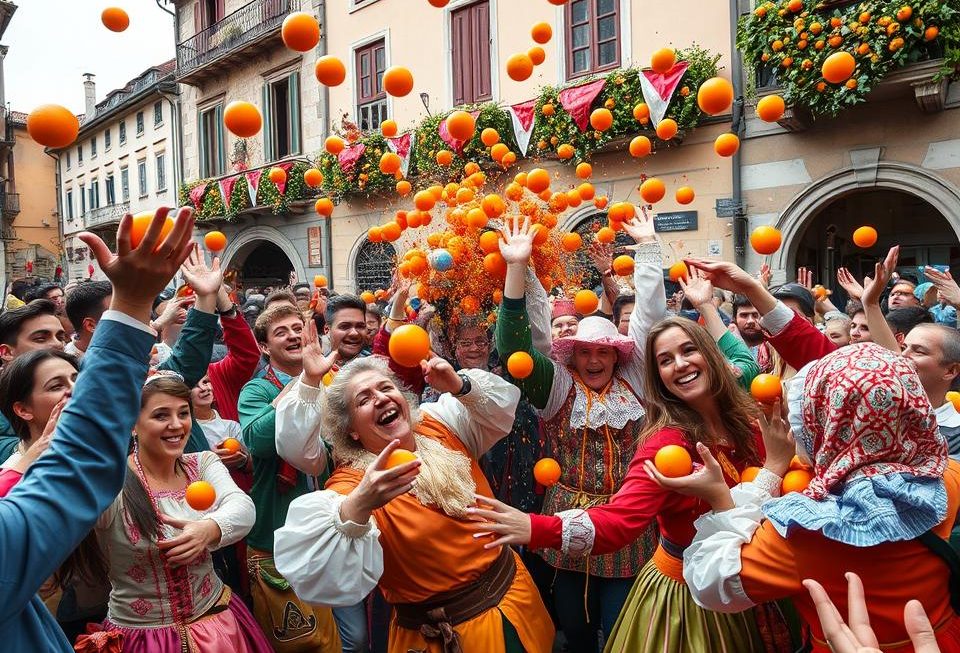Diwali, also known as the “Festival of Lights,” is a big deal in India. It’s a bright celebration that means a lot to billions of people worldwide. This article will dive into Diwali’s origins, traditions, and customs. It will show why it’s so dear to Indians and those of Indian descent.
Read interesting things at : honjo-guruguru
Key Takeaways
- Diwali is a major Hindu festival celebrated annually in India and by the Indian diaspora worldwide.
- The festival symbolizes the triumph of light over darkness, good over evil, and knowledge over ignorance.
- Diwali celebrations involve lighting diyas (oil lamps), exchanging gifts, preparing traditional sweets, and decorating homes with rangoli (colorful patterns).
- Diwali is closely linked to the spiritual and cultural heritage of India, with each region having its own unique customs and traditions.
- The festival is also an important economic event, with a significant impact on India’s retail and consumer sectors.
The Origins and Significance of Diwali
The Diwali festival is deeply rooted in Hinduism. It goes back to ancient Hindu texts and epics. Each region in India celebrates it for its own historical reasons.
The Historical Roots of the Festival
In northern India, Diwali marks Lord Rama’s return after 14 years of exile, as told in the Ramayana. The lighting of lamps celebrates Rama’s win over the demon king Ravana and good’s victory over evil.
In southern India, it honors the birth of the Hindu goddess Lakshmi, the goddess of wealth and prosperity. The festival also tells the story of Lord Krishna defeating the demon Narakasura across the country.
The Spiritual and Religious Importance
Diwali symbolizes the victory of light over darkness, good over evil, and knowledge over ignorance. It’s a time of hope, joy, and new beginnings. Hindus perform puja (prayers) and do various rituals to honor the divine and seek blessings for the year ahead.
The festival is important in the Hindu calendar, starting the new year for many. It’s a time for families to come together, exchange gifts, and celebrate traditions. This strengthens their spiritual traditions and religious celebration.
“Diwali is not just a festival of lights, but a celebration of the triumph of good over evil, knowledge over ignorance, and hope over despair.”
Diwali Celebrations Across India
Diwali, the festival of lights, is a big deal in India. It’s celebrated with lots of joy and different ways across the country. Each region has its own special way of celebrating, showing off India’s rich culture.
In Uttar Pradesh, people tell the story of Lord Ram’s return after 14 years. They light diyas and make rangoli to welcome the gods. They also enjoy sweets like laddoos and barfis.
- In Maharashtra, they focus on Lakshmi, the goddess of wealth. Families do puja and decorate with rangoli.
- In Tamil Nadu, it’s called Deepavali. They celebrate good winning over evil. Homes are decorated with kolam and they eat murukku and adhirasam.
- West Bengal worships Kali, the divine mother. They light diyas, share sweets, and set off fireworks.
Diwali shows off India’s rich culture. It highlights the many ways hindu holiday traditions are kept alive and regional customs are celebrated.
The Festival of Lights
Diwali, known as the “Festival of Lights,” enchants millions in India. It comes from the Sanskrit “Deepavali,” meaning “row of lights.” This festival celebrates light over darkness, knowledge over ignorance, and good over evil.
The Symbolism of Light in Diwali
Light is key to Diwali, symbolizing spiritual enlightenment and inner glow. Lighting diyas (traditional oil lamps) and candles welcomes prosperity, happiness, and new starts.
Traditional Diwali Lighting and Decorations
People decorate homes and businesses with rangoli and diyas. The lights and fireworks create a magical atmosphere. This shows the joy and meaning of the festival of lights.
“The lighting of lamps during Diwali is a symbolic representation of the light of knowledge and truth that dispels the darkness of ignorance and evil.”
Lighting diyas and making rangoli patterns are key traditions. They make the festival of lights more beautiful and meaningful.
Diwali Traditions and Rituals
Diwali, known as the Festival of Lights, is famous for its deep traditions and rituals. These have been kept alive for many years. At the center of these celebrations are the puja (religious ceremonies) and prayers. They honor the divine.
Puja and Prayers
Puja is a key part of Diwali. Devotees come together to worship the gods and goddesses. They recite prayers, make offerings, and fill the air with incense and oil lamp light. This ritual is for deep thought, thanks, and asking for blessings for the future.
Rangoli and Floral Decorations
- Creating rangoli designs is a beloved Diwali tradition. These are made on floors with colored powders, flowers, and other natural stuff.
- They symbolize welcoming prosperity and good luck.
- Floral decorations like marigold garlands and flower arrangements are also used. They make homes and businesses look festive.
These traditions and rituals are the essence of Diwali. They help people connect with their spiritual roots. They celebrate light winning over darkness and look forward to new beginnings.
Diwali Sweets and Savories
No Diwali celebration is complete without traditional Indian sweets and savories. The iconic Gulab Jamun and Barfi are key. So are the crispy Sev and Chakli. These diwali sweets and diwali savories are a big part of the festival. They are often given as gifts to family and friends.
The indian desserts and traditional foods show off India’s rich culinary heritage. Each sweet and savory snack has deep cultural meaning. They reflect the unique tastes and traditions of various regions.
- Gulab Jamun: These soft, spongy dumplings are made from milk and are soaked in a rose-scented syrup. They are a favorite during Diwali.
- Barfi: This fudge-like dessert is made with milk, sugar, and spices like cardamom and saffron. It comes in many shapes and colors.
- Sev: Sev is a crispy snack made from fried chickpea flour. It adds a crunchy texture to Diwali celebrations.
- Chakli: These spiral-shaped snacks are made from rice flour and spices. They are a classic treat during Diwali.
“Diwali is not just a festival of lights, but also a celebration of the rich culinary traditions that bring families and communities together.”
Diwali also brings a variety of regional delicacies to the table. From the rich Kheer of the north to the tangy Undrallu of the south, each dish shows the diversity of Indian flavors. These foods highlight the unity and diversity of the nation.
The Significance of Fireworks in Diwali
Diwali, the Festival of Lights, is a cherished tradition in India. Fireworks are a key part of these celebrations. They fill the night sky with vibrant colors and light. This represents the defeat of evil and the victory of good.
People believe fireworks bring luck and prosperity. The loud sounds and bright lights chase away bad energies. They welcome a new time of positivity and wealth. Fireworks are a big part of Diwali, bringing families and communities together.
Fireworks mean more than just a show. They connect to Diwali’s myths and spiritual side. They celebrate Lord Rama’s win over Ravana and his return to Ayodhya. The fireworks show light over darkness, good over evil, and new beginnings.
| Type of Firework | Symbolic Meaning |
|---|---|
| Sparklers | Represent the sparks of knowledge and enlightenment |
| Crackers | Signify the banishing of evil spirits and negative energies |
| Rockets | Symbolize the ascent of the human spirit towards the divine |
Fireworks in Diwali are a long-standing tradition. They have been part of the festival for centuries. From ancient Vedic texts to today, fireworks capture India’s rich culture and the joy of new beginnings.
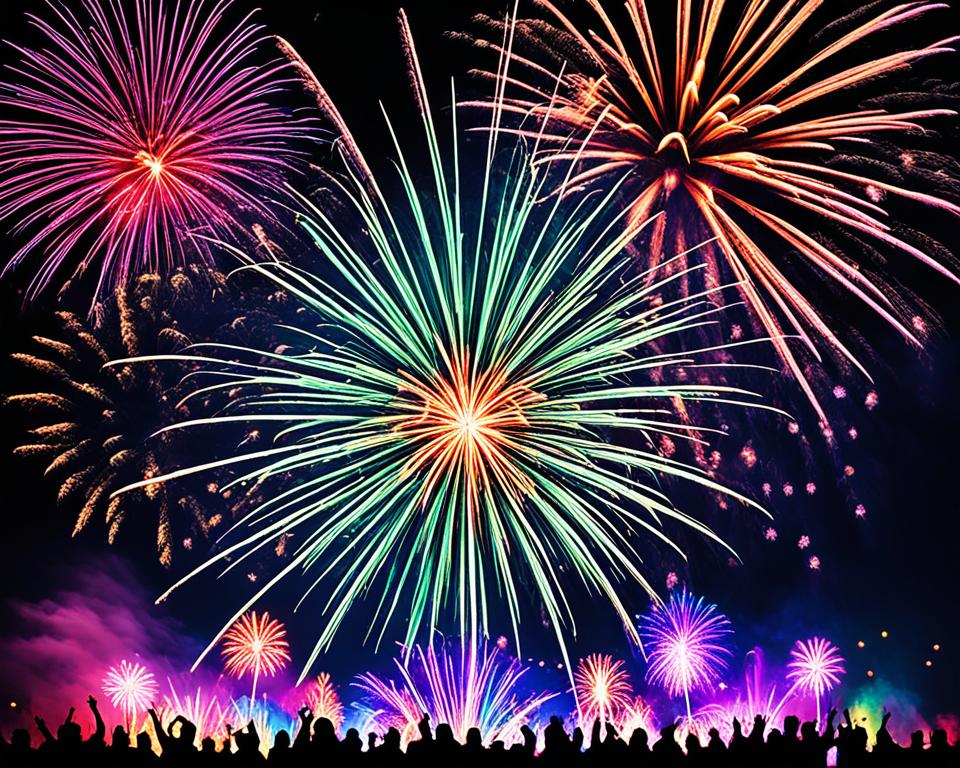
“The burst of fireworks during Diwali is a symbolic representation of the light that dispels the darkness within us and around us, ushering in a new era of hope, prosperity, and harmony.”
Diwali: A Celebration of New Beginnings
Diwali, the Hindu festival of lights, is more than just a celebration of light. It’s a time for new beginnings. For many, it marks the start of the Hindu new year. It’s a chance to look back and look forward with hope.
Diwali is seen as an auspicious time to start new projects, make big decisions, and seek a fresh start.
The tradition of Diwali comes from Hindu mythology and spirituality. It celebrates Lord Rama’s return after defeating Ravana, symbolizing good over evil. This victory gives us a chance for a diwali new beginnings. It’s a time to leave the past behind and welcome a brighter future.
“Diwali is not just a festival of lights, but a time to reflect, renew, and reinvent ourselves. It is an auspicious time to embark on new journeys and embrace the infinite possibilities that lie ahead.”
During Diwali, many Hindus light lamps, exchange gifts, and share diwali new beginnings with loved ones. These traditions mark the hindu new year. They wish for a future full of prosperity, happiness, and spiritual growth.
Diwali is a time for starting new businesses, making big decisions, or just reflecting on the past year. It’s a celebration of the human spirit. It reminds us that hope and renewal are always within reach, even in tough times.
| Significance of Diwali as a Celebration of New Beginnings |
|---|
| Marks the start of the Hindu new year |
| Represents the triumph of good over evil, light over darkness |
| Encourages reflection on the past and optimism for the future |
| Inspires new ventures, important decisions, and personal growth |
| Celebrated through rituals, gifts, and the sharing of diwali new beginnings |
Diwali in Different Regions of India
Diwali, the festival of lights, shines brightly across India. Each region has its own way of celebrating, showing the country’s rich culture. From north to south, people come together to mark this special occasion with their own traditions.
Regional Variations and Customs
In the north, Diwali is all about Lord Rama’s return to Ayodhya. People make beautiful rangoli, light diyas, and set off firecrackers. In the east, like West Bengal, the focus is on Kali Puja and the grand display of lamps by the Ganges.
Heading south, Diwali takes on a unique flavor. In Tamil Nadu, it’s known as Karthikai Deepam, honoring Lord Shiva with lamp lighting. Andhra Pradesh and Telangana decorate cattle with colorful tattoos and accessories.
| Region | Diwali Customs |
|---|---|
| North India |
|
| East India |
|
| South India |
|
The variety in diwali regional variations and diwali customs shows how this festival unites India. It’s a celebration that goes beyond borders, bringing people together in a shared joy.
Diwali Around the World
The Indian diaspora has spread far and wide, taking Diwali, the “Festival of Lights,” with it. Now, Diwali lights up celebrations in the United States, the United Kingdom, Canada, Australia, and more. Communities worldwide come together, sharing traditions and customs of this vibrant festival.
The diwali worldwide celebrations show the strong cultural links between India and its people abroad. In big cities like New York, London, and Toronto, Diwali is celebrated with parades, markets, and fireworks. These events remind us of the deep connections Indians keep with their heritage, even from far away.
“Diwali is a time to celebrate our shared identity and come together as a community, no matter where in the world we may be.”
– Priya Sharma, a member of the Indian-American community in New York City.
Diwali is celebrated in small towns and remote places too, where Indians have made a home. From the Caribbean islands to the Middle East, Diwali brings people together, crossing borders. It’s a time of joy and unity for the Indian community around the world.
- The United States hosts some of the largest Diwali celebrations outside of India, with events in cities like New York, Chicago, and San Francisco.
- In the United Kingdom, Diwali is recognized as an official holiday in several boroughs, reflecting the significant presence of the indian diaspora in the country.
- From Canada to Australia, Diwali celebrations have become an integral part of the cultural fabric, with local governments and communities actively supporting and participating in the festivities.
The diwali worldwide celebrations grow every year, showing the lasting impact of Indian culture. They prove the indian diaspora keeps its traditions alive, no matter where they are in the world.
Diwali Fashion and Jewelry
Diwali, the Festival of Lights, is more than just a spiritual celebration. It’s a time to show off cultural identity with fashion and jewelry. The diwali fashion and diwali jewelry are key parts of this festival. They highlight India’s rich heritage and skill.
Traditional Indian Wear for Diwali
The saree is the star of traditional Indian wear for Diwali. It’s filled with detailed embroidery, bright colors, and royal patterns. The kurta, a long tunic, is also popular, offering a modern twist on diwali fashion.
Dazzling Diwali Jewelry
Stunning diwali jewelry completes any Diwali look. From necklaces, earrings, and bangles to maang tikkas and nose rings, the jewelry reflects Indian culture’s deep heritage. These pieces of traditional Indian wear and jewelry are not just for show. They carry deep symbolic meanings, making them a key part of Diwali.
The diwali fashion and diwali jewelry mix old and new styles. This keeps the spirit of the festival alive through the vibrant clothes and jewelry of the people.
Diwali’s Impact on the Indian Economy
Diwali, the Festival of Lights, is a big deal in India. It’s not just a cultural event but also boosts the economy a lot. It affects the retail, e-commerce, and manufacturing sectors deeply.
During Diwali, people in India buy lots of gifts and shop a lot. This leads to a big jump in economic activity. A study found that Diwali’s effect on the Indian economy could be as high as $15 billion. Most of this money goes to the retail and consumer spending sectors.
There’s a big demand for things like traditional clothes, jewelry, electronics, and home decor. This makes businesses thrive. Retailers and online shops see their sales go up by as much as 40% during Diwali.
| Industry | Diwali Impact |
|---|---|
| Retail | 40% increase in sales |
| E-commerce | 30% increase in online transactions |
| Manufacturing | 20% boost in production |
The manufacturing sector also gets a big lift during Diwali. Companies make more products to meet the demand. This leads to more jobs and helps the economy grow.
“Diwali is not just a festival for us, but a crucial period for our business. The surge in sales during this time can make or break our annual performance.”
– Retail store owner in New Delhi
Diwali’s effect on the Indian economy shows how important the festival is to Indians. It’s a time of celebration and economic growth. The joy of Diwali spreads across the nation, boosting everyone’s prosperity.
Diwali in Popular Culture
Diwali, the vibrant Indian festival of lights, is a big part of the country’s culture. It’s celebrated in movies, books, and more, reaching people in India and beyond. The festival’s traditions and importance are shared through various media.
Diwali in Movies, TV Shows, and Literature
Bollywood often uses Diwali in its stories, making it a key part of the movie. Films like Diwale Dulhania Le Jayenge, Kal Ho Naa Ho, and Dostana show the joy and spiritual side of Diwali. They highlight family time, celebrations, and the festival’s deep meaning.
TV shows also join in the Diwali celebrations. Shows like Sarabhai vs. Sarabhai, Taarak Mehta Ka Ooltah Chashmah, and Yeh Rishta Kya Kehlata Hai have special Diwali episodes. These episodes bring to life the traditions and customs of the festival.
Indian authors also find inspiration in Diwali. Books like The Palace of Illusions by Chitra Banerjee Divakaruni and The Lowland by Jhumpa Lahiri delve into Diwali’s history and its role in characters’ lives. They show how the festival touches different aspects of life.
These cultural pieces in movies, TV, and books entertain and teach us about Diwali. They help us understand the festival’s history and traditions. By sharing Diwali’s stories, these works keep the festival’s spirit alive for everyone to enjoy.
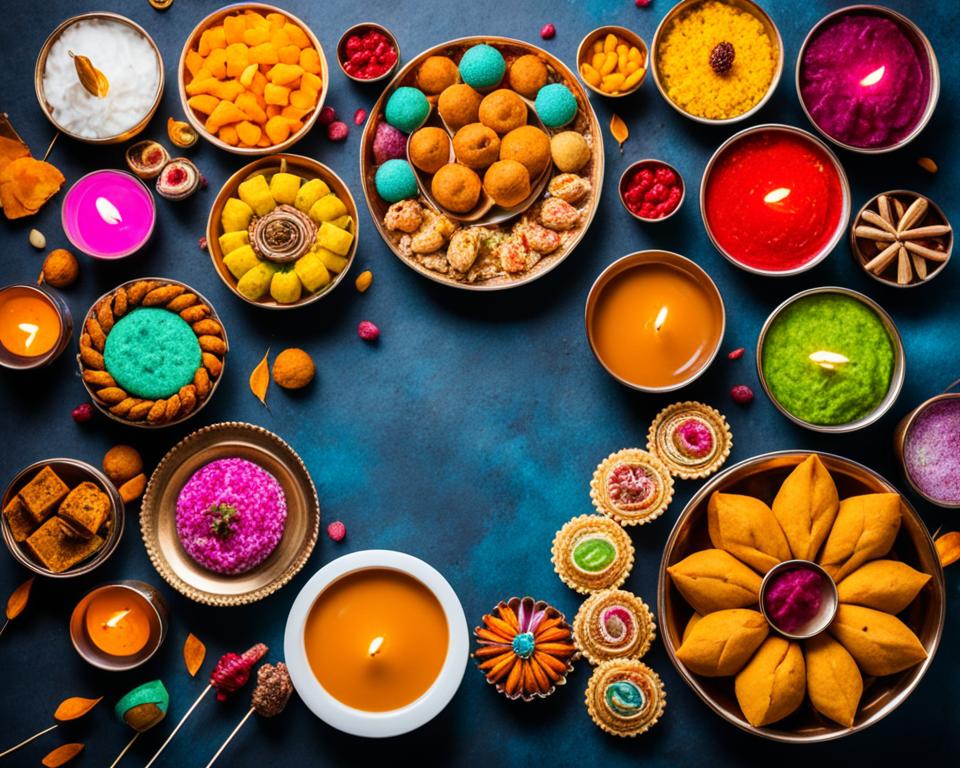
Eco-Friendly and Sustainable Diwali
In recent years, celebrating eco-friendly Diwali has become more popular. People now want to make the festival sustainable and lessen its environmental impact. They’re using eco-friendly lights and promoting green practices to do this.
LED lights and solar-powered lights are now key to eco-friendly Diwali. They use less energy and create less pollution than traditional lights. Also, green firecrackers are becoming popular. They release fewer pollutants and are better for the environment.
- Now, people use biodegradable decorations like flower garlands and rangoli. These replace plastic and non-recyclable materials.
- Proper waste management is now a big part of sustainable celebrations. This includes sorting and disposing of waste correctly.
- Using organic and local ingredients in Diwali sweets and snacks is also becoming more common. This makes the celebration more eco-friendly.
The eco-friendly Diwali movement is growing. It shows that the Festival of Lights can also teach us about taking care of the environment. By choosing green practices, Diwali can celebrate culture and protect our planet.
“Embracing eco-friendly Diwali is not just about reducing our environmental impact, but also about preserving the timeless traditions of this cherished festival for generations to come.”
Conclusion
Diwali, the Festival of Lights, is a key part of India’s cultural heritage. It shows the world the beauty of Indian traditions. This festival brings people together, no matter where they are, in a time of joy and new beginnings.
Diwali means more than just lighting lamps. It’s about light winning over darkness, knowledge beating ignorance, and good overcoming evil. Around the globe, people celebrate Diwali, adopting its traditions and rituals.
As Diwali ends, we remember its lasting spirit. It’s a celebration of different cultures, unity, and human strength. May the Diwali lights guide us towards a future of wealth, peace, and working together for a better world.
